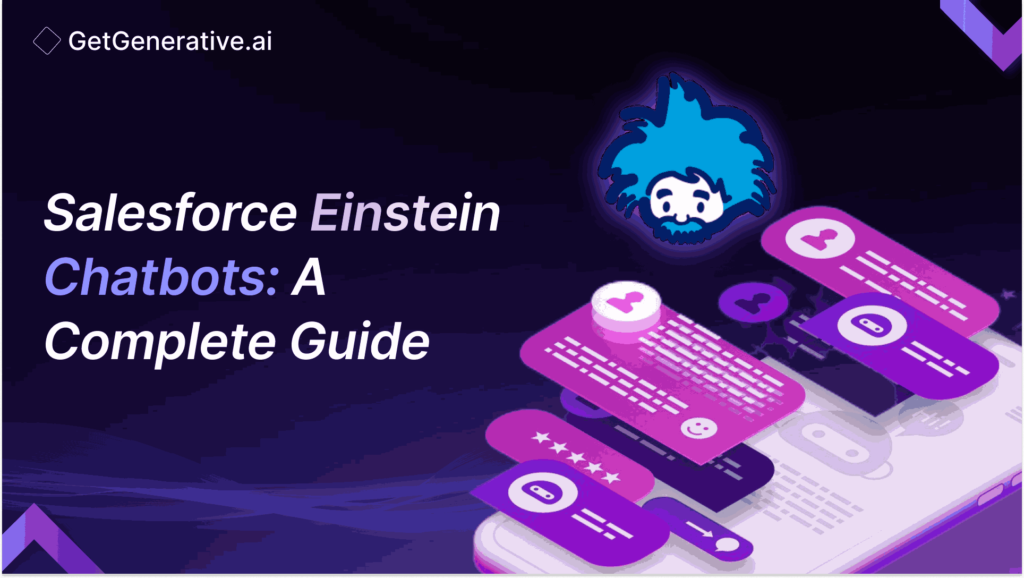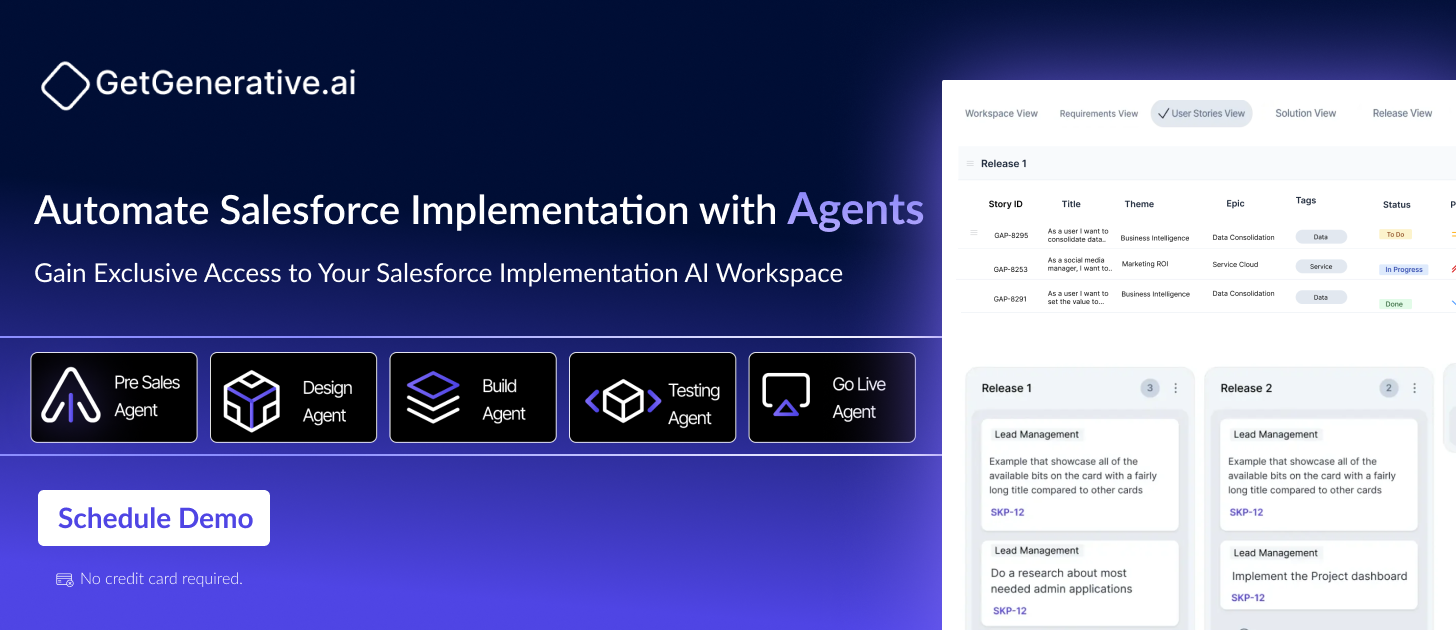Salesforce Einstein Chatbots: A Complete Guide
Among the most transformative technologies emerging in this field are AI-powered chatbots, with Salesforce’s Einstein Chatbots leading the charge. These intelligent systems are redefining responsiveness and setting new standards in customer relationship management through advanced Natural Language Understanding (NLU).
The global chatbot market size is expected to reach USD 27,297.2 million by 2030, registering a CAGR of 23.3% from 2023 to 2030, according to a new report by Grand View Research, Inc. This growth indicates the increasing adoption of customer service solutions that leverage artificial intelligence to enhance user experiences and streamline service operations.
The Advent of AI in Customer Service
Integrating Artificial Intelligence (AI) in customer service has revolutionized how businesses interact with customers. AI technologies, particularly chatbots like Salesforce’s Einstein Chatbots, are not merely automating mundane tasks but are enhancing customer experiences by making interactions smarter and more predictive.
AI-driven systems have been particularly influential in transforming customer service from reactive to proactive. For instance, predictive AI can analyze customer data and previous interactions to anticipate needs and offer solutions before the customer even voices them. This capability allows businesses to offer personalized service at scale, significantly enhancing customer satisfaction and loyalty.
Moreover, AI has made it possible to implement sentiment analysis algorithms that can detect customer emotions and adjust responses accordingly. This level of sensitivity ensures that customers are heard and understood, which is vital for maintaining positive relationships.
What Makes Einstein Chatbots Stand Out?
Einstein Chatbots leverage Salesforce’s robust AI to deliver a seamless service experience. These chatbots are equipped with NLU technology, enabling them to parse and understand customer inquiries in a way that mimics human interaction. This capability improves engagement and enhances the customer’s journey through timely and relevant responses.
Quick Responses
Speed is of the essence in customer service, and Einstein Chatbots excel in this area. They provide immediate answers to customer queries significantly faster than traditional channels like phone or email. This rapid response capability ensures that customers are not left waiting, which can be crucial in maintaining customer satisfaction and loyalty.
Case Deflection
By handling routine inquiries efficiently, Einstein Chatbots effectively reduce the number of new cases that require human intervention. This case deflection frees up valuable resources and allows service teams to focus on more complex or sensitive issues that require a human touch.
Time Efficiency
Einstein Chatbots are not just quick; they are also designed to address and resolve queries without unnecessary delays. This efficiency results in significant time savings for customers and support agents, allowing both parties to focus on priority tasks and improving overall productivity.
Intelligent Evolution
One of the most impressive features of Einstein Chatbots is their ability to learn and evolve over time. Powered by NLU technologies, these chatbots continuously improve, becoming smarter and more adept at handling a variety of customer interactions.
Also Read – Top Salesforce AI Tools 2025 – The Ultimate List
Core Components of Einstein Chatbots
To fully appreciate the capabilities of Einstein Chatbots, it’s essential to understand their core components:
Dialog
Dialogs in Einstein Chatbots are structured to control the flow and capabilities of the conversation. For example, if a customer asks to be connected to a human agent, the bot can seamlessly handle this transition, ensuring a smooth service experience.
Dialog Intent
This component understands the purpose of the customer’s interaction, such as checking the status of an order. The bot can immediately recognize this intent and provide the required information or actions.
Entity
Entities are specific information that the chatbot can recognize and act upon. For instance, if a customer mentions an order number, the bot identifies this as an entity and uses it to fetch order details.
Variable
Similar to Salesforce fields, variables store data within the chatbot’s framework. They help maintain context and manage the conversation’s state.
“Success in creating AI would be the biggest event in human history. Unfortunately, it might also be the last, unless we learn how to avoid the risks.”
– Stephen Hawking, Theoretical Physicist and Cosmologist
Prerequisites for Implementing Einstein Chatbots
Implementing Salesforce Einstein Chatbots requires specific conditions and tools within the Salesforce ecosystem to ensure functionality and optimal performance. Understanding these prerequisites is essential for businesses planning to deploy these AI-driven chatbots effectively.
Service Cloud License
A Service Cloud license is fundamental as it provides access to Salesforce’s service platform, which includes case management, service analytics, and telephony integration. This license is crucial because Einstein Chatbots primarily enhance customer service management and operate within this cloud environment.
Live Agent License
The Live Agent license is essential for real-time online chat capabilities. This license allows agents to engage directly with customers through web-based chat. It is necessary because Einstein Chatbots integrate directly with the Live Agent functionality to manage and escalate conversations as needed.
Also Read – Salesforce Einstein Copilot – The Ultimate Guide
Omni Channel Setup
Setting up Omni Channel is critical for ensuring all communication channels are integrated and managed through a single platform. This includes:
- Presence Configuration: This allows agents to indicate their availability to handle incoming service requests, which is vital for managing the handoff between chatbots and human agents.
- Routing Configuration: Effective routing ensures that queries directed to the chatbot can be transferred to human agents based on their complexity or need for personal attention.
- Service Channel for Live Agent: This creates a specific channel within the Omni Channel setup designated for live chat interactions. This ensures that resources are correctly allocated to manage these engagements efficiently.
Live Agent Deployment
This involves setting up the infrastructure for live agents to interact with customers. This deployment includes configuring chat buttons and chat windows and ensuring all backend systems are aligned to record and manage these interactions within Salesforce seamlessly.
Chat Enablement
Enabling the chat functionality within Salesforce is crucial before deploying an Einstein chatbot. This is done through the Salesforce setup menu, where chat settings can be configured to define how chat interactions are initiated, managed, and concluded across customer touchpoints.
Additional Considerations
- Queue for Chatbot Agents: Establishing a dedicated queue for chatbot agents helps efficiently manage the flow of interactions and ensures a smooth transition between bots and human agents.
- User Permissions: Agents must have the correct permissions within the Service Cloud to interact with the system and make necessary adjustments or escalations.
By meeting these prerequisites, organizations can ensure that their deployment of Salesforce Einstein Chatbots is successful and that the bots are well-integrated into the existing customer service framework, providing a seamless transition between automated interactions and human touchpoints.
Also Read – Salesforce Einstein Explained
Implementing Einstein Chatbots
The implementation of an Einstein Chatbot involves several critical steps:
- Enable Chat: Enable chat in your Salesforce org through the Chat Settings.
- Enable Einstein Bots: Use the Quick Find box to navigate to Einstein Bots and activate them.
- Create a New Bot: Decide whether to start from scratch or use a template. This step includes defining the bot type, such as Standard or Enhanced, and customizing it to fit your needs.
- Personalization: Assign a name, choose the language, and define a welcome message to personalize the chatbot.
- Activation: Finally, link actions or menus to the bot and activate it to start interacting with customers.
Conclusion
Einstein Chatbots represent a significant leap forward in using AI in customer service. By automating responses and intelligently handling customer interactions, these chatbots enhance the efficiency of service departments and elevate the overall customer experience. As these technologies continue to evolve, they will play a pivotal role in shaping the future of customer service, making it more responsive, personalized, and effective.
Enhance your Salesforce consulting with GetGenerative.ai. Effortlessly craft outstanding proposals, enabling you to dedicate more time to providing exceptional client service.
Start today!
Frequently Asked Questions (FAQs)
1. What are Salesforce Einstein Chatbots?
Einstein Chatbots are AI-powered systems by Salesforce that use natural language understanding to improve customer service interactions.
2. How do Einstein Chatbots improve response times?
They provide immediate answers to common customer questions significantly faster than traditional communication channels.
3. What is case deflection in the context of Einstein Chatbots?
Case deflection refers to chatbots’ ability to handle routine queries effectively, reducing the need for human intervention.
4. Can Einstein Chatbots evolve over time?
Yes, powered by NLU technologies, these chatbots learn from interactions and continuously improve their response quality and understanding.
5. What prerequisites are needed to implement Einstein Chatbots?
To implement Einstein Chatbots, you need a Service Cloud license, a Live Agent license, an Omni Channel setup, and a Live Agent Deployment.




